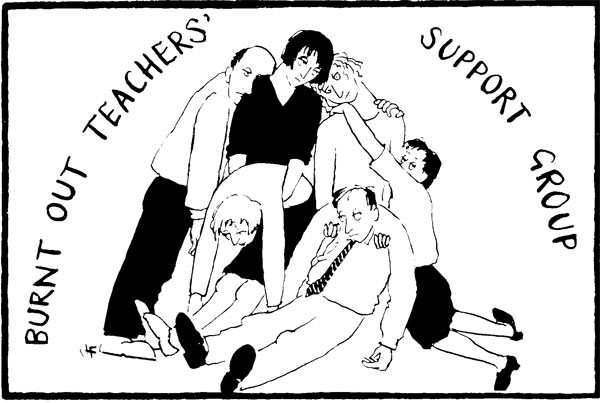We have a looming crisis in education. Teacher retention is an increasing issue in the UK. Four out of every 10 new teachers quit within 5 years and recent reports by the National Audit Office says teachers leaving the profession has increased by 11 per cent in the last three years. So what can be done?

Although we clearly need change at the macro level what happens within individual schools matters to how people feel about working there. What leaders do determines whether school culture supports or undermines teacher motivation, resilience and retention. Based on research on wellbeing in education and also what we know motivates people here are suggestions that might make a difference.
1. Acknowledge teachers. Most are highly conscientious but rarely get thanks for the many little things they do every day. In one school the front page of the weekly newsletter is a note of thanks - to parents, cleaners or office staff as well as teachers. This has initiated a culture of noticing and gratitude, not only within the school gates but also in the local community.
2. It is overload that drives most teachers out of teaching. So help teachers prioritise. No-one can do everything to the best of their ability all the time without burning out. What needs high quality attention and what would be ‘good enough’?
3. Recognise that teachers have lives outside school - often with families who need attention and care. Heads can take a lead by being a role model. One CEO of a large corporate in Australia routinely goes home at 5pm to spend time with his children before bed. He often works at his computer afterwards but this gives permission to his staff to value time with their own families. When teachers do put in the extra hours during certain demanding periods perhaps have a social gathering afterwards to thank families for their support?
4. Build social capital. The quality of the teacher-student relationship is fundamental to effective education - but schools are ecologies so how staff relate to each other impacts on interactions in the classroom. Relational qualities such as respect, kindness and trust all exist in the micro-moments of everyday interactions. Head teachers need to pay attention to the relational culture of their school. Otherwise it is like having an aquarium you never clean - creatures thrash about but cannot thrive. Professional learning on relationship building can help, but modelling emotional literacy is the starting point. Good leadership is relational.
Try the ‘secret angel’ intervention. Teachers volunteer to put their names in a hat at the beginning of term and pull out another. They then keep a caring eye on that person during the term - making them a cup of tea, asking how they are doing, celebrating a birthday. It doesn’t take much but provides on-going social support and can make the difference between drop out or hanging in there.
5. Staff meetings are often not relevant to everyone. Time is such a valuable commodity in school. It needs to be clear what a meeting is for, who should come and why? Everyone needs to leave a meeting thinking it was a worthwhile use of time.
6. Give teachers a voice. This does not mean allowing the loudest or most negative to dominate. Mix everyone up and ask pairs or small groups to discuss pros and cons of new initiatives. One teacher said ‘I know the school executive have to make the final decision about things but it’s easier to go along with these if I feel I’ve been genuinely consulted’.
7. Encourage creativity and innovation. Teachers are invariably intelligent people with ideas. When all they are expected to do is go through a set curriculum and get reports done on time, it’s no wonder they decide that teaching is not for them. Schools that are places of learning and experiment are exciting. One idea worth considering is the ‘flipped classroom’ where pupils research a topic for homework on the internet or watch a video made by their teacher so come to school primed with knowledge and questions. The work in class is on understanding and application. This is proving an effective tool to engage students whose behaviour may otherwise be disruptive; another reason teachers opt out.
8. Share resources. Teachers often re-invent the wheel. The more sharing of resources the less preparation work for each individual and hence the reduction of overload. This is more likely to happen in a culture based on collaboration rather than competition.
9. Use a strengths based approach. Help everyone identify their particular strengths and then provide opportunities to use and develop these. Language in education is often focused on deficit and an expectation of homogeneity. The language of strengths, solutions and diversity is not only positive for pupils it is also motivating for teachers.
10. Raise the oxytocin! Stressed teachers are full of cortisol. This impacts on their cognitive functioning and can undermine mental health. Where there are opportunities for playfulness and laughing together this raises oxytocin. Oxytocin is mostly involved in reproductive functions but also fosters connectedness and reduces anxiety. One head teacher employs a masseuse once a month to do 10 minute massages for staff. This not only makes them feel valued it also raises oxytocin
11. Introduce #teacher5aday. Martyn Reah and group of teachers in Southern England have developed a twitter based network based on the National Economics Foundation Five Ways to Wellbeing Framework - Notice, Connect, Give, Keep Learning, Stay Active. They are helping each other stay upbeat - and in the profession!
Sue Roffey is an Adjunct Associate Professor in the School of Education at Western Sydney University and an international authority on issues of wellbeing in education. See www.sueroffey.com
Related articles
-
Refugee education: a patchwork, not a ladder
Laura Partridge
Laura Partridge writes about an inspirational Fellow-led project in refugee education that closely reflects the findings of the RSA’s recent Cities of Reciprocity report.
-
Blog: What’s the purpose of education?
Ellen Spencer Bill Lucas
Bill Lucas and Ellen Spencer of the Centre for Real-World Learning at the University of Winchester explore the true purpose of education
-
Blog: Please ignore this blog
Tom Gilliford
Tom Gilliford questions why it took leaving the teaching profession for his ideas and initiatives to be taken seriously.




Join the discussion
Comments
Please login to post a comment or reply
Don't have an account? Click here to register.
Thanks Sue, great article. I will be using some of these methods with my management team who are not teachers but do work in education. I particularly like the "strength based approach" since the creativity involved in leading a specific area of interest can lead to extra recognition and the release of oxytocin. The pressures on schools is changing so the skills and focus of the entire workforce needs to evolve. The health and wellbeing of teachers and pupils is something that needs to become higher priority within education systems, both at policy and local levels.